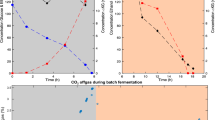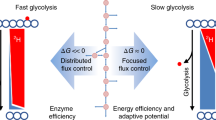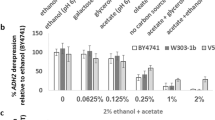Abstract
Ethanol and lactate are typical waste products of glucose fermentation. In mammals, glucose is catabolized by glycolysis into circulating lactate, which is broadly used throughout the body as a carbohydrate fuel. Individual cells can both uptake and excrete lactate, uncoupling glycolysis from glucose oxidation. Here we show that similar uncoupling occurs in budding yeast batch cultures of Saccharomyces cerevisiae and Issatchenkia orientalis. Even in fermenting S. cerevisiae that is net releasing ethanol, media 13C-ethanol rapidly enters and is oxidized to acetaldehyde and acetyl-CoA. This is evident in exogenous ethanol being a major source of both cytosolic and mitochondrial acetyl units. 2H-tracing reveals that ethanol is also a major source of both NADH and NADPH high-energy electrons, and this role is augmented under oxidative stress conditions. Thus, uncoupling of glycolysis from the oxidation of glucose-derived carbon via rapidly reversible reactions is a conserved feature of eukaryotic metabolism.

This is a preview of subscription content, access via your institution
Access options
Access Nature and 54 other Nature Portfolio journals
Get Nature+, our best-value online-access subscription
$29.99 / 30 days
cancel any time
Subscribe to this journal
Receive 12 print issues and online access
$259.00 per year
only $21.58 per issue
Buy this article
- Purchase on Springer Link
- Instant access to full article PDF
Prices may be subject to local taxes which are calculated during checkout





Similar content being viewed by others
Data availability
Data are shown in the figures and supplementary figures. Requests for materials can be made to the corresponding author. Source data are provided with this paper.
References
Weinhouse, S., Warburg, O., Burk, D. & Schade, A. L. On respiratory impairment in cancer cells. Science 124, 267–272 (1956).
Wolfe, A. J. The acetate switch. Microbiol. Mol. Biol. Rev. 69, 12–50 (2005).
De Deken, R. H. The Crabtree effect: a regulatory system in yeast. J. Gen. Microbiol. 44, 149–156 (1966).
Bui, L. T. et al. Conservation of ethanol fermentation and its regulation in land plants. J. Exp. Bot. 70, 1815–1827 (2019).
Kotte, O., Volkmer, B., Radzikowski, J. L. & Heinemann, M. Phenotypic bistability in Escherichia coli’s central carbon metabolism. Mol. Syst. Biol. 10, 736 (2014).
Hui, S. et al. Glucose feeds the TCA cycle via circulating lactate. Nature 551, 115–118 (2017).
Kruckeberg, A. L. & Dickinson, J. R. Metabolism and Molecular Physiology of Saccharomyces cerevisiae (Taylor & Francis, 2004).
Verduyn, C., Zomerdijk, T. P. L., van Dijken, J. P. & Scheffers, W. A. Continuous measurement of ethanol production by aerobic yeast suspensions with an enzyme electrode. Appl. Microbiol. Biotechnol. 19, 181–185 (1984).
DeRisi, J. L., Iyer, V. R. & Brown, P. O. Exploring the metabolic and genetic control of gene expression on a genomic scale. Science 278, 680–686 (1997).
Kotyk, A. & Alonso, A. Transport of ethanol in baker’s yeast. Folia Microbiol. (Praha). 30, 90–91 (1985).
Pronk, J. T., Yde Steensma, H. & Van Dijken, J. P. Pyruvate metabolism in Saccharomyces cerevisiae. Yeast 12, 1607–1633 (1996).
Van den Berg, M. A. et al. The two acetyl-coenzyme A synthetases of Saccharomyces cerevisiae differ with respect to kinetic properties and transcriptional regulation. J. Biol. Chem. 271, 28953–28959 (1996).
Jong-Gubbels, P., Berg, M. A., Steensma, H. Y., Dijken, J. P. & Pronk, J. T. The Saccharomyces cerevisiae acetyl-coenzyme A synthetase encoded by the ACS1 gene, but not the ACS2-encoded enzyme, is subject to glucose catabolite inactivation. FEMS Microbiol. Lett. 153, 75–81 (2006).
Buu, L. M., Chen, Y. C. & Lee, F. J. S. Functional characterization and localization of acetyl-CoA hydrolase, Ach1p, in Saccharomyces cerevisiae. J. Biol. Chem. 278, 17203–17209 (2003).
Otterstedt, K. et al. Switching the mode of metabolism in the yeast Saccharomyces cerevisiae. EMBO Rep. 5, 532–537 (2004).
Brauer, M. J., Saldanha, A. J., Dolinski, K. & Botstein, D. Homeostatic adjustment and metabolic remodeling in glucose-limited yeast cultures. Mol. Biol. Cell 16, 2503 (2005).
Park, J. O. et al. Metabolite concentrations, fluxes and free energies imply efficient enzyme usage. Nat. Chem. Biol. 12, 482–489 (2016).
Grabowska, D. & Chelstowska, A. The ALD6 gene product is indispensable for providing NADPH in yeast cells lacking glucose-6-phosphate dehydrogenase activity. J. Biol. Chem. 278, 13984–13988 (2003).
Zhang, Z., Chen, L., Liu, L., Su, X. & Rabinowitz, J. D. Chemical basis for deuterium labeling of fat and NADPH. J. Am. Chem. Soc. 139, 14368–14371 (2017).
Benson, T. E., Marquardt, J. L., Marquardt, A. C., Etzkorn, F. A. & Walsh, C. T. Overexpression, purification, and mechanistic study of UDP-N-acetylenolpyruvylglucosamine reductase. Biochemistry 32, 2024–2030 (1993).
Collinson, L. P. & Dawes, I. W. Inducibility of the response of yeast cells to peroxide stress. J. Gen. Microbiol. 138, 329–335 (1992).
Christodoulou, D. et al. Reserve flux capacity in the pentose phosphate pathway by NADPH binding is conserved across kingdoms. iScience 19, 1133–1144 (2019).
Shenton, D. & Grant, C. M. Protein S-thiolation targets glycolysis and protein synthesis in response to oxidative stress in the yeast Saccharomyces cerevisiae. Biochem. J. 374, 513 (2003).
Minard, K. I. & Mcalister-Henn, L. Sources of NADPH in yeast vary with carbon source. J. Biol. Chem. 280, 39890–39896 (2005).
van Hoek, M. J. A. & Merks, R. M. H. Redox balance is key to explaining full vs. partial switching to low-yield metabolism. BMC Syst. Biol. 6, 22 (2012).
Vemuri, G. N., Eiteman, M. A., McEwen, J. E., Olsson, L. & Nielsen, J. Increasing NADH oxidation reduces overflow metabolism in Saccharomyces cerevisiae. Proc. Natl Acad. Sci. USA 104, 2402–2407 (2007).
Yu, T. et al. Reprogramming yeast metabolism from alcoholic fermentation to lipogenesis article reprogramming yeast metabolism from alcoholic fermentation to lipogenesis. Cell 174, 1549–1558 (2018).
Sakihama, Y., Hidese, R., Hasunuma, T. & Kondo, A. Increased flux in acetyl-CoA synthetic pathway and TCA cycle of Kluyveromyces marxianus under respiratory conditions. Sci. Rep. 9, 5319 (2019).
Lee, F. J. S., Lin, L. W. & Smith, J. A. Acetyl-CoA hydrolase involved in acetate utilization in Saccharomyces cerevisiae. Biochim. Biophys. Acta 1297, 105–109 (1996).
Fleck, C. B. & Brock, M. Re-characterisation of Saccharomyces cerevisiae Ach1p: fungal CoA-transferases are involved in acetic acid detoxification. Fungal Genet. Biol. 46, 473–485 (2009).
Chen, Y., Zhang, Y., Siewers, V. & Nielsen, J. Ach1 is involved in shuttling mitochondrial acetyl units for cytosolic C2 provision in Saccharomyces cerevisiae lacking pyruvate decarboxylase. FEMS Yeast Res. 15, fov015 (2015).
Tu, B. P., Kudlicki, A., Rowicka, M. & McKnight, S. L. Cell biology: logic of the yeast metabolic cycle: temporal compartmentalization of cellular processes. Science 310, 1152–1158 (2005).
Brauer, M. J. et al. Coordination of growth rate, cell cycle, stress response, and metabolic activity in yeast. Mol. Biol. Cell 18, 3250–3263 (2007).
Gibney, P. A., Lu, C., Caudy, A. A., Hess, D. C. & Botstein, D. Yeast metabolic and signaling genes are required for heat-shock survival and have little overlap with the heat-induced genes. Proc. Natl Acad. Sci. USA 110, E4393–E4402 (2013).
VanderSluis, B. et al. Broad metabolic sensitivity profiling of a prototrophic yeast deletion collection. Genome Biol. 15, R64 (2014).
Bennett, B. D., Yuan, J., Kimball, E. H. & Rabinowitz, J. D. Absolute quantitation of intracellular metabolite concentrations by an isotope ratio-based approach. Nat. Protoc. 3, 1299–1311 (2008).
Lu, W. et al. Metabolomic analysis via reversed-phase ion-pairing liquid chromatography coupled to a stand alone orbitrap mass spectrometer. Anal. Chem. 82, 3212–3221 (2010).
Agrawal, S. et al. in High-Throughput Metabolomics. Methods in Molecular Biology, Vol. 1978 (ed. D’Alessandro, A.) 301–321 (Humana Press, 2019).
Su, X., Lu, W. & Rabinowitz, J. D. Metabolite spectral accuracy on orbitraps. Anal. Chem. 89, 5940–5948 (2017).
Young, J. D. INCA: a computational platform for isotopically non-stationary metabolic flux analysis. Bioinformatics 30, 1333–1335 (2014).
MATLAB 9.7.0.1190202 (R2019b) (MathWorks, 2018).
Acknowledgements
We thank S. Silverman and D. Botstein for access to the yeast knockout collection; T. TeSlaa, R. Ryseck and A. J. Cowan for feedback on the manuscript; I. Pelczer and J. Eng for assistance with NMR and mass spectrometry; C.M. Call for help with preliminary experiments; and M. Seyedsayamdost and members of the Rabinowitz laboratory for helpful discussions. Services, results and/or products in support of the research project were generated by the Rutgers Cancer Institute of New Jersey Metabolomics Shared Resource, supported, in part, with funding from NCI-CCSG P30CA072720-5923. This work was funded by U.S. Department of Energy grant DE-SC0018260 and the Department of Energy Center for Advanced Bioenergy and Bioproducts Innovation (award no. DE-SC0018420). Any opinions, findings, conclusions or recommendations expressed in this publication are those of the author(s) and do not necessarily reflect the views of the U.S. Department of Energy.
Author information
Authors and Affiliations
Contributions
T.X. and J.D.R. designed the study. T.X. performed NMR studies. T.X. and A.K. performed isotopic tracing studies. T.X., Y.H., L.C. and A.K. developed the computational models. T.X. and A.K. analyzed the data. J.D.R. and T.X. wrote the manuscript, with the help from all authors.
Corresponding author
Ethics declarations
Competing interests
The authors declare no competing interests.
Peer review
Peer review information
Nature Chemical Biology thanks Jens Nielsen, Kiran Patil and Aljoscha Wahl for their contribution to the peer review of this work.
Additional information
Publisher’s note Springer Nature remains neutral with regard to jurisdictional claims in published maps and institutional affiliations.
Extended data
Extended Data Fig. 1 Environmental ethanol consistently provides acetyl units across two S. cerevisiae strains.
(a) Ethanol production rate from [U-13C]glucose (mean, SE, n=3 biological replicates). Results are similar to literature29 value of 10.5 mmol*(OD*h)−1. (b) Glucose uptake rate from the same experiment as in a (mean, SE, n=3 biological replicates), comparable to literature value29 of 6.9-7.6 mmol*(OD*h)−1. (c) The [M+2] labeling of acetyl-CoA in S.cerevisiae FY4 with equimolar glucose and [U-13C]ethanol measured as a function of time in labeled ethanol (mean, SE, n=3 biological replicates). The consistent labeling fraction from 30 min to 1 h implies that 1 h is a pseudo-steady-state measurement. (d) After incubation with glucose and [U-13C]ethanol for 1 hour at varying conditions and strains, the [M+2] labeled acetyl-CoA fraction from the cell (mixture of cytosolic and mitochondrial origins) was directly measured by LC-MS (mean, SE, n=3 biological replicates). (e) Examples of q13C NMR spectra of the yeast culture media upon addition of [U-13C]glucose and after S. cerevisiae growth for 1 h.
Extended Data Fig. 2 Environmental ethanol does not enter glycolytic intermediates in fermenting S. cerevisiae.
(a) After natural isotope correction, no meaningful [M+2] fraction is observed in glycolytic intermediates: fructose-1,6-phosphate (FBP), dihydroxyacetone phosphate (DHAP), hexose-6-phosphates (G6P+F6P), or UDP-D-glucose (S. cerevisiae, equimolar glucose:[U-13C]ethanol, mean, SE, n=3 biological replicates). (b) As in a, for equicarbon condition. (c) Example of the natural abundance observed in raw mass spectra of FBP. The natural abundance is corrected by the binomial distribution model37 to arrive at the labeling patterns reported throughout the manuscript including a and b above.
Extended Data Fig. 3 Environmental ethanol feeds fatty acid synthesis to a similar extent across the equimolar and equicarbon conditions.
(a) 13C-isotope labeling pattern of palmitic acid from S. cerevisiae FY4 (S288c) switched to and incubated in minimal media (YNB) with equimolar or equicarbon glucose: [U-13C]ethanol (mean, SE, n=3 biological replicates). (b) 13C isotope labeling pattern of stearic acid from the same experiments as shown in a (mean, SE, n=3 biological replicates). (c) Whole-cell and cytosolic acetyl-CoA labeling from [U-13C]ethanol is similar. Whole-cell labeling is directly measured by LC-MS of acetyl-CoA (mean, SE, n=3 biological replicates). Cytosolic labeling is inferred from fatty acids labeling patterns (mean ± SE, results from both C16:0 and C18:0 are averaged, resulting a total n=6 measurements from n=3 biological replicates). The directly measured whole-cell acetyl-CoA is the same data as shown in Fig. 1e.
Extended Data Fig. 4 Ethanol contribution to mitochondrial acetyl-CoA is blocked by knocking out ACH1.
(a) Glu and NAG labeling from the experiment in Fig. 1d with equicarbon glucose: [U-13C]ethanol (mean, SE, n=3 biological replicates; ***, p<.001, by two-sided t-test). Briefly, while Glu is labeled up to [M+2], NAG [M+4] arises from the reaction of [M+2] Glu with mitochondrial [M+2] acetyl-CoA, which depends on Ach1. (b) Mitochondrial acetyl-CoA [M+2] fraction fitted from glutamate and NAG labeling in a (mean, SE, n=3 biological replicates). (c) Schematic showing ACH1 as the exclusive point of entry for carbons from ethanol or acetate into mitochondrial acetyl-CoA (Created with BioRender). (d) Directly measured cellular acetyl-CoA [M+2] labeled fraction is similar across media conditions or strains including the ACH1 knockout strain (mean, SE, RM one-way ANOVA with Geisser-Greenhouse correction, p= .097 (ns), .19(ns), n=3 biological replicates). FY4 is isogenic to S288c and ∆ach1 is from S288c, while CEN.PK is derived from ENY.WA-1A and MC996A.
Extended Data Fig. 5 Carbons from [U-13C]ethanol feed into TCA intermediates across media conditions and budding yeast strains/species.
Some data for S.c. FY4 and I.o. SD108 are repeated from main Fig. 3b,c (mean, SE, n=3 biological replicates).
Extended Data Fig. 6 The environmental ethanol contribution to TCA intermediates is concentration-dependent.
Labeling pattern of TCA intermediates from the indicated budding yeast grown starting at OD = 0.1 in standard high glucose media (55 mM regular glucose) with the indicated concentrations of [U-13C]ethanol for 1 h (mean, SE, n=3 biological replicates). Note that, for the lower 13C-ethanol concentrations, the labeled ethanol is substantially diluted by unlabeled ethanol made from the unlabeled glucose during the duration of the experiment. In S. cerevisiae, this is about a 10-fold dilution for the 50 μM condition and 2-fold for the 500 μM condition. Thus, the above labeling patterns conservatively underestimate the contribution of low concentrations of environmental ethanol to TCA intermediates.
Extended Data Fig. 7 Deuterium tracing into NAD(P)H is similar across media conditions and strains.
(a) Scheme depicting NADP2H and NAD2H production from [1,1-2H2]ethanol isotope tracer. (b) Labeled fractions of NADPH active hydride with the tracer in a. The values are computed from matrix decompositions of labeling distributions of NAD(P)H and NAD(P)+ that are directly measured by LC-MS (mean, SE, n=3 biological replicates). (c) As in b, for NADH (mean, SE, n=3 biological replicates). (d) Chemical scheme depicting NADP2H production from [1-2H]glucose via the first step of oxPPP. (e) Labeled fractions of NADPH active hydride with the tracer in d (mean, SE, n=3 biological replicates). (f) As in e, for NADH (mean, SE, n=3 biological replicates). (g) Chemical basis of D2O active hydride exchange with NAD(P)H16. (h) The fraction of NADPH hydride exchanged with water, as measured in media swap experiment with 50% D2O (mean, SE, n=3 biological replicates). (i) As in h, for NADH (mean, SE, n=3 biological replicates).
Extended Data Fig. 8 ALD6 knockout shifts NADPH production (and thus fatty acid hydride labeling) towards the oxidative pentose phosphate pathway and ZWF knockout shifts it towards the ethanol-ALD6 pathway.
(a) 2H isotope labeling pattern of palmitic and stearic acids from S. cerevisiae FY4 and ∆ald6 swapped into equimolar [1-2H]glucose: ethanol for 1 h (mean, SE, n=3 biological replicates). (b) As in a, for equicarbon [1-2H]glucose: ethanol (mean, SEM, n=3 biological replicates). (c) 2H isotope labeling pattern of palmitic and stearic acids from S. cerevisiae FY4 and ∆ald6 swapped into equimolar glucose: [1,1-2H2]ethanol for 1 h (mean, SE, n=3 biological replicates). (d) As in c, for equicarbon glucose: [1,1-2H2]ethanol (mean, SE, n=3 (biological replicates)).
Extended Data Fig. 9 Fatty acids in S. cerevisiae are labeled from D2O (50%) reflecting direct water incorporation during fatty acid synthesis and H-D exchange between water and NADPH.
(a) 2H isotope labeling pattern of palmitic acid from S. cerevisiae FY4 swapped into regular glucose media with 50% D2O for 1 h (mean, SE, n=3 biological replicates). (b) As in a, for stearic acid.
Extended Data Fig. 10 The fructose-1,6-bisphosphate (FBP) pool size acutely increases in response to oxidative stress.
FBP pool size, after treatment with 20 mM hydrogen peroxide in S. cerevisiae FY4 grown in glucose+ethanol. The increase in FBP pool size after the oxidative stress is statistically significant (mean, SE, n=6 biological replicates, slope > 0 by linear regression, p=0.03).
Supplementary information
Source data
Source Data Fig. 1
Statistical Source Data.
Source Data Fig. 2
Statistical Source Data.
Source Data Fig. 3
Statistical Source Data.
Source Data Fig. 4
Statistical Source Data.
Source Data Fig. 5
Statistical Source Data.
Source Data Extended Data Fig. 1
Statistical Source Data.
Source Data Extended Data Fig. 2
Statistical Source Data.
Source Data Extended Data Fig. 3
Statistical Source Data.
Source Data Extended Data Fig. 4
Statistical Source Data.
Source Data Extended Data Fig. 5
Statistical Source Data.
Source Data Extended Data Fig. 6
Statistical Source Data
Source Data Extended Data Fig. 7
Statistical Source Data.
Source Data Extended Data Fig. 8
Statistical Source Data.
Source Data Extended Data Fig. 9
Statistical Source Data
Source Data Extended Data Fig. 10
Statistical Source Data.
Rights and permissions
Springer Nature or its licensor holds exclusive rights to this article under a publishing agreement with the author(s) or other rightsholder(s); author self-archiving of the accepted manuscript version of this article is solely governed by the terms of such publishing agreement and applicable law.
About this article
Cite this article
Xiao, T., Khan, A., Shen, Y. et al. Glucose feeds the tricarboxylic acid cycle via excreted ethanol in fermenting yeast. Nat Chem Biol 18, 1380–1387 (2022). https://doi.org/10.1038/s41589-022-01091-7
Received:
Accepted:
Published:
Issue Date:
DOI: https://doi.org/10.1038/s41589-022-01091-7
This article is cited by
-
Metabolic heterogeneity and cross-feeding within isogenic yeast populations captured by DILAC
Nature Microbiology (2023)



